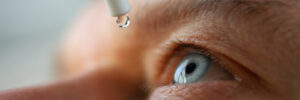Dry eye is a condition in which there are insufficient quality tears in the eye. Tears are important for the comfort and health of the eyes as well as for maintaining clear vision. Tears are made up of 3 main components: an aqueous or watery portion, a mucous portion and an oily portion. The aqueous part provides the bulk of the moisture while the mucous helps the moisture spread over and adhere to the surface of the eye and the oily part reduces evaporation. Symptoms of dry eye include redness, burning, stinging, blurry or fluctuating vision and watery eyes.
Causes
There are two main types of dry eye. The first is when the body is making insufficient tears. This can be due to aging or from sjogrens, which is an auto-immune condition. The more common type is due to poor quality tears, usually because of a deficient oil layer which leads to dryness due to increased evaporation. Many factors can contribute to this type of dry eye including age, gender (more common in women) and medications such as antihistamines, decongestants, blood pressure medications, and antidepressants. Some medical conditions such as rheumatoid arthritis, diabetes, and thyroid problems as well as blepharitis (inflammation of the eyelids) can also contribute to dry eyes. Finally, wind, dry climate and infrequent or incomplete blinking such as when using electronic devices can also increase dryness.
Prevention
While dry eye can be a troublesome condition there are a number of actions that can reduce the risk or severity. First, remembering to blink regularly, especially when on electronics is an important step to keeping the eye hydrated. It is a natural tendency to stare and blink less when looking at a screen. A good rule of thumb to remember is 20/20: about every 20 minutes take a break for about 20 seconds and look at something at least 20 feet away and blink about 20 times. This helps to prevent both eye strain and dryness from prolonged screen time. Adjusting our environment is also important. Avoid air from fans, car heaters, etc. blowing directly in the eyes and face. If the air is particularly dry, a humidifier can help as well and make sure to stay hydrated by drinking plenty of water. Also, taking supplements or eating a diet rich in essential fatty acids can help support healthy tear production and reduce dry eye.
Treatment
Sometimes, the preventative measures above are not enough. When that is the case, there are a number of options for treating dry eye. One of the most common is over the counter artificial tears or lubricating drops. In addition to adding moisture to the eyes, a quality artificial tear helps support the mucous and oil layers of the tears. In some cases the eyelids do not close completely while sleeping. In these cases there are artificial tears available in gel and ointment form for use while sleeping. Warm compresses on the eyelids and cleansing lids scrubs are two other very effective methods which work by reducing inflammation and helping the eyes produce better quality tears. For difficult cases there are also prescription medications such as Restasis® and steroid drops as well as other options that can aid in managing dry eye disease.

More information can be found at https://www.aoa.org/healthy-eyes/eye-and-vision-conditions/dry-eye?sso=y or schedule an appointment with one of our doctors at Desert Family Eye Care who can diagnose and determine the best course of treatment for your individual case.
Devin T. Whipple, OD


